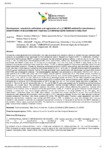Use este identificador para citar ou linkar para este item:
http://www.alice.cnptia.embrapa.br/alice/handle/doc/1068083| Título: | Development, uncertainty estimation and application of a LC-MS/MS method for simultaneous determination of acrylamide and 4hydroxy2,5-dimethyl-3(2H)-furanone in baby food. |
| Autoria: | PETRARCA, M. H.  ROSA, M. A.   QUEIROZ, S. C. do N. de   GODOY, H. T.   |
| Afiliação: | M. H. PETRARCA, FEA/Unicamp; MARIA APARECIDA ROSA, CNPMA; SONIA CLAUDIA DO N DE QUEIROZ, CNPMA; H. T. GODOY. |
| Ano de publicação: | 2016 |
| Referência: | In: IBERO-AMERICAN, 1.; BrMASS CONFERENCE ON MASS SPECTROMETRY, 6., 2016, Rio de Janeiro. Resumos Eletrônicos... São Paulo: Sociedade Brasileira de Espectrometria de Massas, 2016. |
| Conteúdo: | Acrylamide, a heatgenerated food contaminant, has been associated with neurotoxic effects in humans and was classified under group 2A as a probable human carcinogen by the International Agency Research on Cancer (IARC) [1]. Additionally, hydroxy2,5dimethyl3(2H)furanone (DMHF), a furanic compound, has demonstrated genotoxic effects in vitro as also in vivo [2]. In this study, a new accurate liquid chromatographytandem mass spectrometry method was developed for simultaneous analysis of acrylamide and DMHF in baby food. To the best of our knowledge, this is the first study on DMHF in baby foods as well as pioneer in acrylamide monitoring in baby foods from Brazil. For this, a sample preparation method was optimized, which involves acetonitrile-based extraction, followed by dispersive solidphase extraction (dSPE) using primary and secondary amine sorbent (PSA) and then, a final cleanup of extract by solid phase extraction (SPE). An ACQUITY ultraperformance liquid chromatography (UPLC) system interfaced to a Quattro Premier XE triple quadrupole mass spectrometer with electrospray ionization (ESI) source (WATERS) was employed for analysis. The chromatographic separation was achieved on a C8 column (150 mm x 2.1 mm i.d., 5?m particle size) at 30ºC with a flow rate of 0.2 ml/min, and the injection volume was 20 ?l. The mobile phases consisted of MilliQ water (A) and acetonitrile (B), both containing 0.01% of formic acid, and the elution gradient employed was as follows: 0 min, 5% B? 5 min, 50% B? 5.1 min, 100% B? 6?10 min 5% B, resulting in a total run time of 10 min. Data acquisition was carried out in selective reaction monitoring (SRM) mode employing ESI in positive mode, whose conditions were: capillary voltage 3 KV? temperatures of source at 120°C and desolvation at 400°C and gas flow 500 L/h. The collision energy and cone voltage were 10 and 25 V. The m/z 55 and 44 (acrylamide) and m/z 101 and 83 (DMHF) were used respectively for quantitative and confirmative purposes. As a great result, the optimized sample preparation method provided sufficient removal of potential analytical interfering commonly present in fruitbased matrices, the amino acid valine, without affecting the sensitivity, trueness and precision of the method. Limits of detection (LOD) and quantification (LOQ) of 10 and 20 ?g/kg were obtained for both analytes. Linearity in solventonly and matrixmatched calibration curves was achieved in the range between 10 and 300 ?g/kg, with determination coefficients higher than 0.99. Matrix effects, calculated from slopes obtained for solvent and matrixmatched calibrations, were observed for acrylamide (?45%) and DMHF(?11%). Recoveries between 75 and 115% were obtained for the two studied compounds from blank baby foods spiked at 20 (LOQ), 100 and 200 ?g/kg. Precision, under repeatability and withinlaboratory reproducibility conditions, was verified with RSD values < 20%. In addition, by using data obtained from inhouse validation, was possible to estimate the expanded measurement uncertainty for the levels of acrylamide and DMHF detected in the samples, whose values were lower than 25%. The applicability of proposed analytical method was evaluated by analyzing 20 baby food samples available in Brazilian markets. |
| Thesagro: | Poluente |
| NAL Thesaurus: | Infant foods Acrylamides |
| Palavras-chave: | Food contaminants Baby Food LCMS/MS Contaminante Acrylamide metabolite Food contaminant |
| Tipo do material: | Resumo em anais e proceedings |
| Acesso: | openAccess |
| Aparece nas coleções: | Resumo em anais de congresso (CNPMA)  |
Arquivos associados a este item:
| Arquivo | Descrição | Tamanho | Formato | |
|---|---|---|---|---|
| 2016RA027.pdf | 107,03 kB | Adobe PDF |  Visualizar/Abrir |









